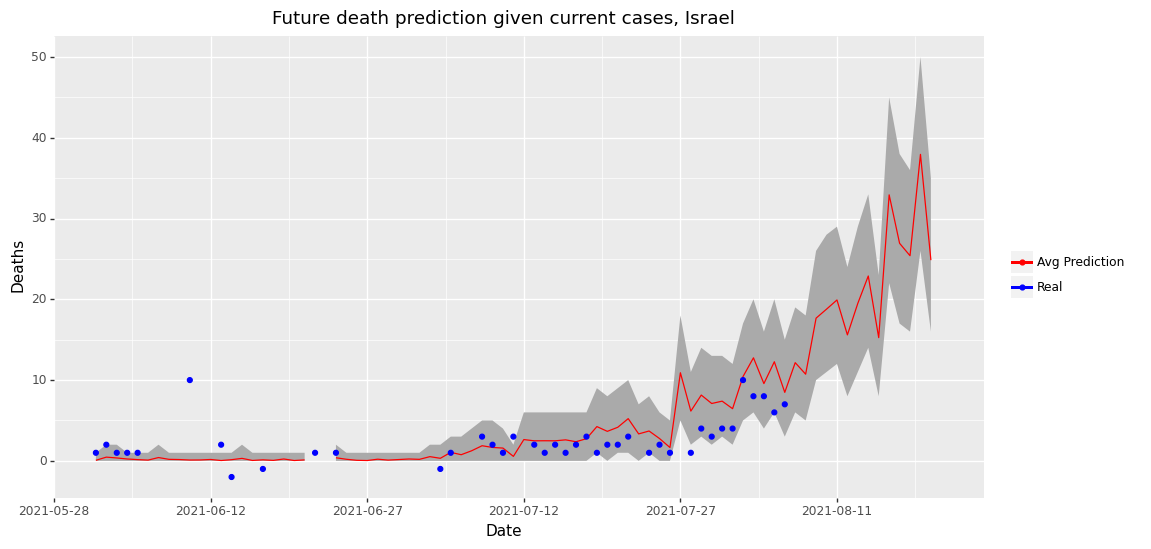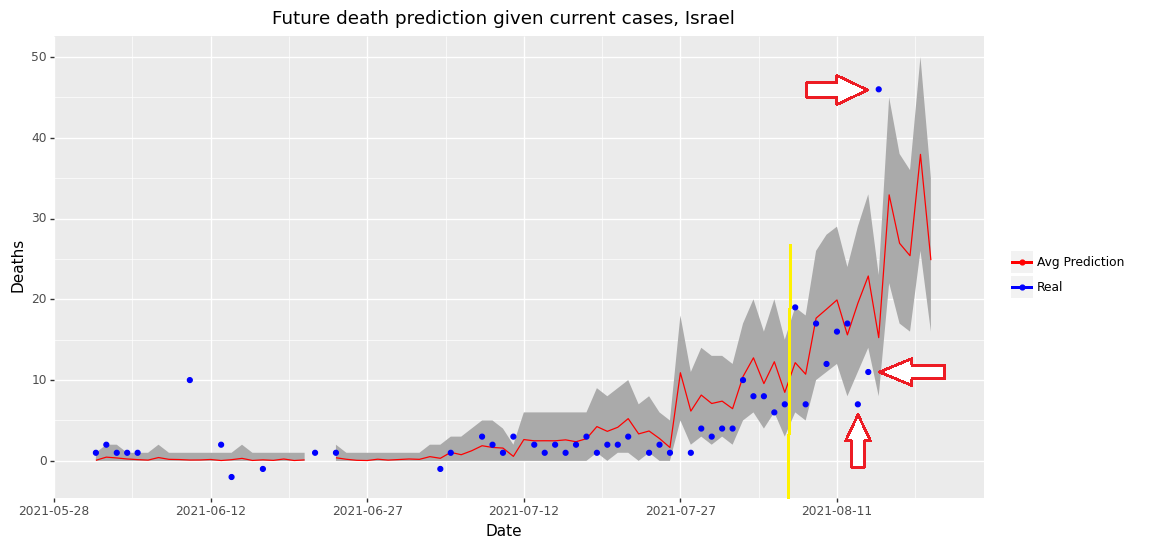Are Cases "Decoupled" From Deaths?
Misinformation about vaccine effectiveness has made people unprepared for possible outcomes
For those familiar with my article “Lies, Damned Lies, and Vaccine Statistics,” we took apart the misinformation that people have been spreading about just what kind of protection the vaccines give you.
It continues to be asserted that the vaccines give you roughly 90% additional protection from death after you’ve been infected, than you would have if you were unvaccinated and became infected.
If you read my article (consider doing so if you haven’t yet) you would know that there is insufficient evidence to make this claim in the generic situation, and some evidence to make a claim of some reduction in the infection death rate for the oldest populations. But nothing approaching 90% or more as has been spread widely.
Some people have been saying that “cases are ‘decoupled’ from deaths” in places where the population is partially vaccinated, and a spike in cases has been observed. They mean to communicate that the reason there are so many cases and so few deaths is because the vaccine, even if infected, protects you greatly from death. They do not make any observations or qualifications about, perhaps, the vast majority infections mostly being in the unvaccinated younger ages who rarely die.
Real world test
Unfortunately we may see soon, that in very real terms, this claim of additional protection does not hold and that cases are not really “decoupled” from deaths. And people will notice. Cases in Israel are currently experiencing exponential growth, the same kind of growth that became the center of numerous stories at the start of the pandemic to explain the concept to the average citizen.

As of April 3rd 2021, according to the Haas et al massive surveillance study I reviewed in a previous article, Israel’s adult population was 72.1% vaccinated.
And according to Our World in Data (Oxford) via 91-divoc.com the number of people fully vaccinated has climbed to 5.8 million out of 6.5 million, or roughly 89%.
At the time of the Haas study, the only vaccine available was the Pfizer BNT162b2 mRNA vaccine. It appears the Moderna vaccine is also now available but I am not sure what percentage of the population has it.
The crudest of predictions
What you are looking at is the crudest model one might generate to make a prediction. Over the course of the pandemic we saw some proportion of new cases each day that, approximately 14 days later, become deaths. Looking at that history, coming up with an estimate of that case-death ratio (14 days out), and only using that estimate, we take the cases now to predict deaths 14 days later (with bands capturing 95% of the prediction probability).
The data used was pulled on August 7th, and the blue dots in the graph above are up to August 6th1. The latest day predicted above is August 20th. The estimate is made only looking at data from the start of the pandemic up to January 24th, 2021, when the Haas study that established “98.5% effectiveness at preventing death” began.
This prediction is crude. It is a bit more sophisticated than eyeballing an estimate, but not by much. It should fail dramatically in the scenario that the cases are among the vaccinated and vaccination provides strong additional layers of protection against death once infected. It should also fail dramatically if the infections are consolidating in the unvaccinated younger ages who rarely die.
If it fails we can try to see which, if any, of those scenarios were the case. Or if some not yet considered possibility occurred, such as 14 days delay no longer being reasonable.
What if it doesn’t fail dramatically?
Situations like this are filled with hundreds of variables that make comparing one situation to the next very difficult, and increases the likelihood of misinterpretation. It would not be correct, even if this crude prediction winds up holding, to conclude nothing has changed. Lots of things have definitely changed.
Not everyone is vaccinated, and not all age groups are vaccinated equally. At the time of writing this, I have not delved into the new cases to see what percentage of them are in which age groups or vaccination status. As of April 3rd, 90% of the most vulnerable age group, 65+, were already vaccinated and 62% in the least vulnerable 16-44 age group were. Since 89% are now vaccinated overall the remaining unvaccinated in any group is much smaller, but still able to be those who wound up infected.
I do not know if Israel has segregated the vaccinated from the unvaccinated. I do not know what proportion of cases are Delta or some other variant.
There are many variables to consider and things that have changed where, if this prediction winds up being decently accurate, one might find a way to say the “vaccine is effective but what this data doesn’t show…”
Many or all of those hypothetical objections might be valid and worth discussing. But the more salient proximate issues would be overlooked. People will notice and people will want answers. Those who are focused on promoting universal-vaccination will not be prepared to answer those questions because they’ve been making up numbers off the top of their head.
If this prediction2 winds up holding fairly well then we have a post-universal-vaccination scenario where
The ability of the virus to spread will not appear to have been impeded to any significant degree, despite a vaccination rate often considered above “herd immunity," and despite the hypothetical protection vaccination gives relative to people who largely no longer exist (the unvaccinated) — the ability for spread to become exponential and cause daily infections of the kind we were shutting down the global economy for, can still happen
The arguments used to promote universal-vaccination, such as doing so obviously protects you from death even if you get infected, do not obviously hold after universal-vaccination
Whether it is more infectious variants, that existed before the vaccination operation started, or behavior changes causing increased spread, roughly the same proportions of those who become infected can still die as before
Squandering opportunities
Hopefully this crude prediction model will be a monumental failure. If so, then we should see deaths hover in the single digits, because there is a significant additional layer of protection afforded by the vaccines and cases don’t matter as much. I have yet to see that happen in any of the other data that takes cases into account, but of course I have not seen all data in all situations.
Or this model will fail because the bulk of infections were in a younger unvaccinated age group, who rarely die. I have seen that in other data sets but not specifically in a country with 89% vaccination. That might be undesirable long term when thinking about future mutations that evade vaccines, but would be good enough for now, as fewer people will die.
But if this crude model holds even mostly, then this will become yet another contentious data point that universal-vaccination advocates will try to wave away somehow. We have been, and continue to be, setting people up with terribly false expectations about how the vaccines protect from death once infected. We’ve been lying to people and telling them that the only choice, that is both necessary and sufficient to end the pandemic, is to vaccinate a population above the level of “herd immunity” without exception (or the rarest of exceptions where you have to get everyone’s individualized approval or you’ll be bombarded with 1000 people demanding to know your whole medical history before they accept your answer). If this crude prediction model holds people will notice.
Once pretty much the whole population is vaccinated that option can no longer be a panacea. If you’re trying to mislead people into thinking that all they have to do is get vaccinated and from then on there are no further concerns, you can continue to invent counterfactual scenarios about how many people would have gotten infected and died in some parallel dimension. But we live in this dimension. To the degree populations are already vaccinated, from 50% to 90%, we need to maximize that benefit in those vaccinated groups.
Those benefits cannot be maximized through misinformation about additional layers of protection.
Note
This prediction model is not what I am personally predicting to happen. I do not know what will happen. Its utility is to say in advance, based on what the past looked like, what the future would like if it looked similar to the past. No matter the underlying reasons, if it winds up looking similar to the past, people will notice and it will be hard to just wave away.
Update 8/10/2021
The first few new data points3 are in for days 8/7, 8/8, and 8/9. 19, 7, and 17. Each within the model’s 95% prediction bounds.
Update 8/11/2021
Yesterday’s deaths (8/10) were reported to be 12. Again within the 95% prediction bounds.
Update 8/12/2021
Yesterday’s deaths (8/11) were reported to be 16. Again within the 95% prediction bounds. (yellow lines now indicates where post-prediction data begins)
Update 8/13/2021
Yesterday’s deaths (8/12) were reported to be 17. Again within the 95% prediction bounds. (yellow lines now indicates where post-prediction data begins)
Update 8/16/2021
Three new values since last update for 8/13, 8/14, and 8/15. They are 7, 11, and 46 respectively. (yellow lines now indicates where post-prediction data begins). Outside of the prediction bounds, but unfortunately not all on the low side.
Update 8/17/2021
If one were to evaluate the model, the model is losing accuracy. The last four data points have avoided the 95% prediction bounds. But unfortunately it just seems like the model is late by a day, which means the number of people predicted to die over time is fairly accurate.
Yesterday’s (8/16) Israel recorded 19 deaths, under the lower bound of the prediction which was 22.
Update 8/18/2021
The recorded number of deaths on 8/17, was 17.
Update 8/19/2021
Two new data points have come in since the last update. 8/18 and 8/19 with 19 and 29 deaths respectively. Both within the prediction bounds, unfortunately.
Update 8/20/2021
Today the last data point (8/20) is in, 7 deaths, and is very far below the predicted bounds. The wide disparity, 46 deaths one day, 26 another, to 7, clearly show the crude model isn’t capturing all factors involved in the daily numbers (it is narrower) - but I think the end conclusion is that this model was too accurate for as simple as it was. It should have failed miserably.
I will be writing a retrospective that includes a deeper dive in the near future.
Update 8/24/2021
Many have asked what the results of this prediction model/data would have looked like smoothed. I incorporated a 7-day rolling average to the results. The smoothing is applied after the model generation, not before.
If you noticed that a few points are negative, we are getting our data from John Hopkins via 91-divoc.com, and that is unfortunately what they report. Perhaps it is a correction for a previous day mistake. I’m glad those two people came back to life even if it makes prediction a bit fuzzier.
95% prediction bounds in the graph in number of deaths
2021-08-07 (6 - 19)
2021-08-08 (5 - 18)
2021-08-09 (10 - 26)
2021-08-10 (11 - 28)
2021-08-11 (12 - 29)
2021-08-12 (8 - 24)
2021-08-13 (11 - 29)
2021-08-14 (14 - 33)
2021-08-15 (8 - 23)
2021-08-16 (22 - 45)
2021-08-17 (17 - 38)
2021-08-18 (16 - 36)
2021-08-19 (26 - 50)
2021-08-20 (16 - 35)












